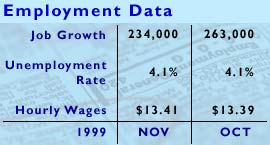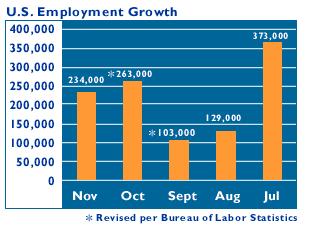|
Job growth in line
|
 |
December 3, 1999: 2:28 p.m. ET
November employment up 234,000, wages up 0.1%, jobless rate steady
By Staff Writer M. Corey Goldman
|
NEW YORK (CNNfn) - Job creation grew at a modest pace in November while wages barely budged and the unemployment rate held steady at a 29-year low, the government reported Friday, setting the stage for the U.S. economy to set a record for its longest period of expansion ever.
The economy generated 234,000 new jobs last month, the Labor Department said, slightly more than economists’ forecasts of a 226,000 gain. October’s job growth was revised down to 263,000 from an initially reported gain of 310,000 jobs.
Average hourly wages, closely watched on Wall Street as a harbinger of inflation pressure, rose 2 cents to $13.41 an hour, a smaller-than-expected increase of 0.1 percent. The jobless rate remained at 4.1 percent, the lowest since January 1970.
"These numbers tell us the labor market remains firm but it’s not becoming firmer,” said Anthony Chan, a senior economist at Banc One Investment Advisors. "Yes, the economy is growing rapidly, but it’s not taking off to the races.”
And with growth strong and inflation benign, the economy looks poised to continue a record-setting expansion that began in April 1991. February will mark the 107th consecutive month of economic growth; the current record is 106 months between February 1961 and December 1969.
"We are in the midst of the longest peacetime economic expansion in American history,” President Clinton said Friday in a White House speech trumpeting the economic growth. "If, as seems highly likely, it goes on through February, it will become the longest economic expansion in our history.”
Stocks, bonds soar
The report sent stocks surging to record highs and bonds soaring as investors concluded that employment and wage gains are contained enough to convince the Federal Reserve to hold the line on interest rates.
Of recent concern to Wall Street analysts and Fed officials has been the shrinking pool of available workers. If businesses have difficulty finding workers, the theory goes, they will have to boost wages and benefits to attract employees, which could lead to price increases and a pickup in inflation.

But November’s report indicated the pool of available workers actually grew. The pool of available labor rose to 9.46 million in October from 9.39 million, without accounting for seasonal adjustments usually made to account for fluctuations in the numbers.
"These data are consistent with a gentle slowing in economic growth and, although labor markets are still very tight, little wage pressures,” said Steven Wood, an economist at Banc of America Securities in San Francisco. ”There was a sigh of relief at the FOMC,” he said, referring to the Fed’s Federal Open Market Committee of policy makers.
The Fed factor
The Fed last month lifted short-term interest rates by a quarter point -- the third increase this year -- in an effort to slow the economy and keep inflation under wraps. It lifted its trend-setting Fed funds rate to 5.5 percent from 5.25 percent.
At that time, the Fed also said it was switching its bias toward raising rates again to "neutral” from "tightening.” But Fed officials took the somewhat unusual step of explaining what could affect their decision to raise rates again in the future: the growing shortage of American workers.

"The pool of available workers willing to take jobs has been drawn down further in recent months, a trend that must eventually be contained if inflationary imbalances are to remain in check and economic expansion continue," the Fed said.
Analysts now believe the Fed will have little reason to take that action. Fed officials next meet Dec. 21 -- four days before Christmas and 11 days before the start of 2000. Because the meeting is so near the holidays, few analysts expect the Fed to raise rates again. The central bank’s next meeting after that is in early February.
A great number
"This is a great number,” said Ronald Hill, chief strategist at Brown Brothers Harriman. "Strong job growth and no real pressures on the wage side is exactly what the Fed wants to see.”
Within the report, service-producing employment rose by 181,000 in November, bolstered by business services, health care and social work, the Labor Department said. The number of retail jobs rose 1,000 after declining in October. Manufacturing employment fell 2,000 last month and construction employment jumped by 55,000.
The average number of hours worked rose to 34.6 in November from 34.5 during October.
Even with November’s gains, overall job creation is starting to slow. On average, companies have added a total of 200,000 jobs a month since August, compared to 214,000 a month for the year so far and 244,000 a month in all of 1998.
Productivity gains
Of course, a growing number of economists and analysts are convinced that the reason so many people can have jobs without wages rising is because of rising productivity.
Traditional economic models say strong growth and record employment -- features of the economy for several years now -- should lead to a pickup in inflation, and eventually a recession.
But that has yet to happen -- something a growing number of economists attribute to more worker output per hour as well as stiff global competition. A big contributor has been technology -- including the Internet -- that allows people to work more efficiently and allows companies to reduce costs and keep a lid on prices to compete.
"The productivity numbers have been spectacular, but will they continue? That’s the $64 question,” said Stephen Roach, chief economist at Morgan Stanley Dean Witter.
Some remain hesitant
To be sure, some economists were still hesitant to step up to the New Economy punchbowl, indicating the economy is still growing at a robust pace and that inflation, while contained, is under pressure.
"The economy is red-hot, the labor market is super-tight, and while wage trends are not accelerating there is still plenty of pressure,” said Sherry Cooper, chief economist at brokerage Nesbitt Burns Inc. "As things currently stand, we would still look for the Fed to shift to a tightening bias at the Dec. 21 FOMC meeting, a prospect which is not in the market.”
Separately, the Commerce Department said new orders at U.S. factories declined 0.2 percent in October, less than the 0.6 percent drop expected by economists and above the revised 1 percent decline recorded in September.
Reduced demand for electrical equipment and engines spurred the second monthly decline in a row. Excluding transportation, orders fell 0.5 percent after dropping 0.4 percent the month before. 
|
|
|
|
|
 |

|

